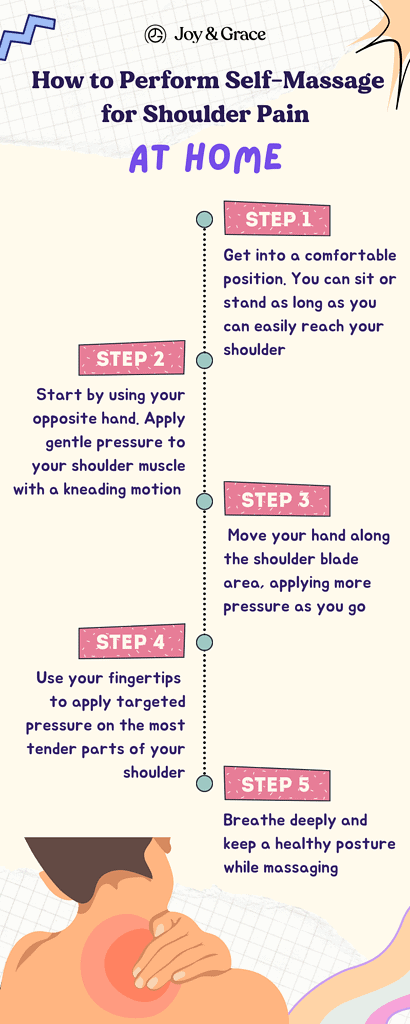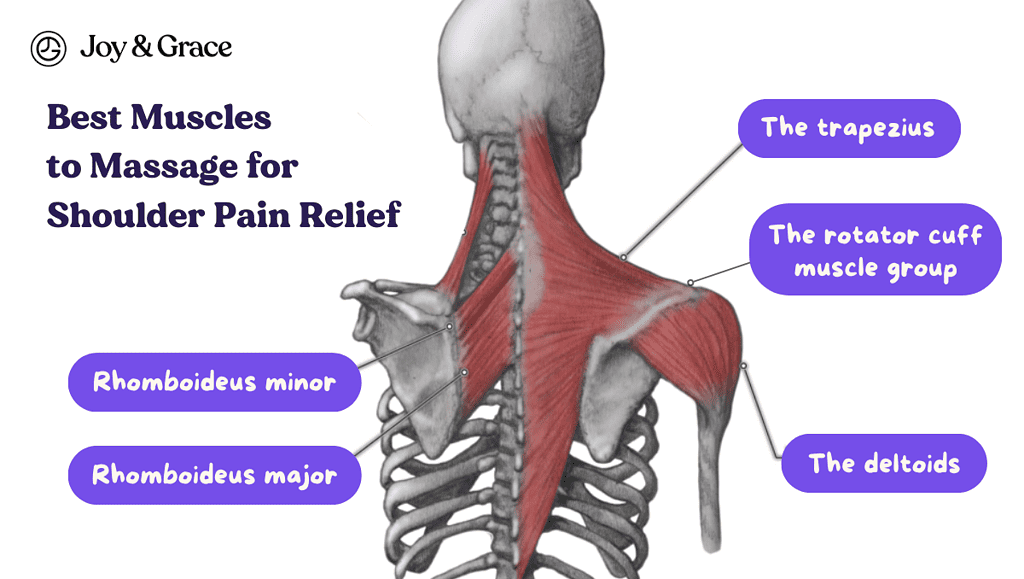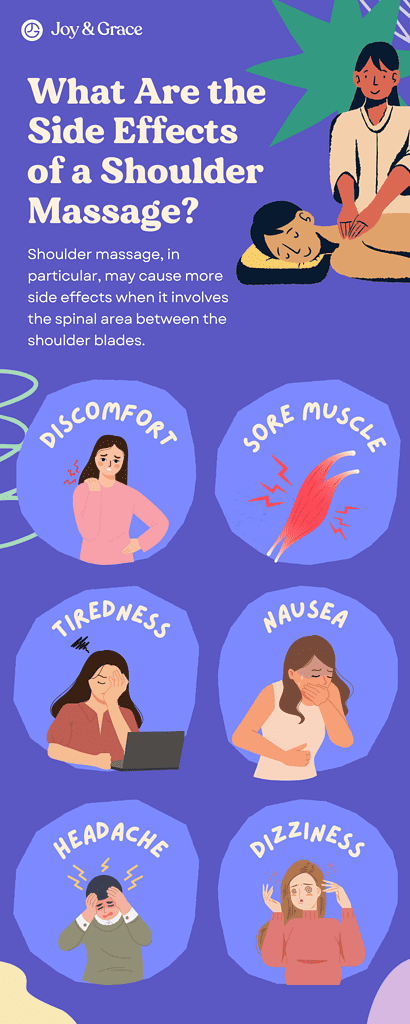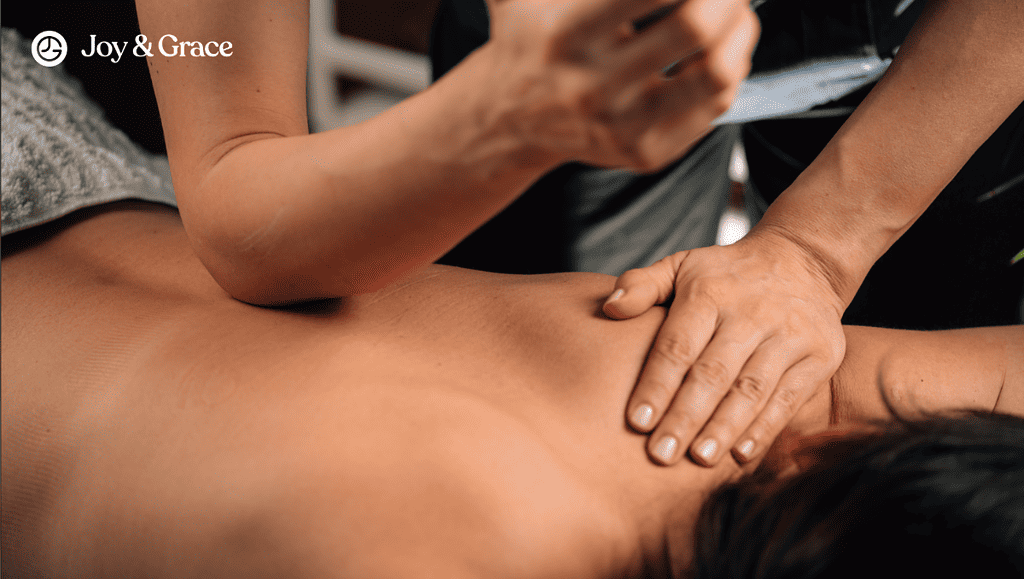If you have been struggling with persistent shoulder pain, you are not alone. Shoulder pain is a common musculoskeletal complaint. It can limit mobility and make even simple daily tasks seem difficult. But did you know that massage therapy might provide just what you were searching for to get rid of this pain?
This article will guide you through the many types of massage therapy for shoulder pain. Throughout the article, we aim to answer questions on the types, benefits, and success rate of massage techniques for shoulder pain. So, sit back and relax, because relief might be only a few precise kneads and strokes (and paragraphs) away!
The Role of Massage Therapy in Managing Shoulder Pain

Massage therapy has long been regarded as one of the most effective ways to manage shoulder pain. Massage for shoulder pain focuses specifically on relieving tension in the affected shoulder area.
This often results in substantial pain reduction. It is not just about physical pain relief, though. Massage therapy can also promote mental relaxation! But how exactly does a massage help with shoulder pain? Let us find out.
How Can Massage Relieve Shoulder Pain?
Contrary to what some might say, massage therapy is not just another wellness trend. There is actual scientific research that supports it.
Based on the results of a comprehensive study, massage therapy is an excellent complementary treatment method for shoulder pain. It works by reducing tension in muscles and associated tissues in the shoulder and shoulder blade regions.
Therapists can reach the many layers of muscle and fascia through various techniques. These techniques include kneading, stroking, and compression, among others.
Here are the main mechanisms by which massage therapy relieves tension:
- It boosts blood circulation and oxygen supply. This action is achieved by heating the targeted areas through massage. More blood and oxygen help with faster tissue healing.
- It reduces inflammation. It achieves this by changing the signaling pathways of the inflammatory process.
- It promotes the stimulation of pressure receptors. This action enhances the activity of a nerve called "the vagus nerve.” An increased activity of this nerve means relaxation and loosening of tightness and pressure.
- It lowers cortisol levels. Cortisol is also known as the “stress hormone.” Elevated cortisol levels due to prolonged stress can negatively impact health.
- It increases the levels of feel-good hormones in the brain. These hormones include serotonin and dopamine.
So, benefits all around! Let us now focus on what massage therapy can do for shoulder pain.
What Causes Shoulder Pain and How Can Massage Help?
Shoulder pain is a common complaint in the US. It can result from many causes, such as:
- Rotator cuff injuries and disorders
- Shoulder Impingement Syndrome
- Arthritis in the shoulder joint
- Bone growth or spurs in the shoulder area
- Bursitis. Bursitis is inflammation of a fluid-filled sac (bursa) that normally protects and lubricates the joint.
- Frozen shoulder (Adhesive capsulitis). This condition occurs when the shoulder muscles, tendons, and ligaments become stiff.
- Shoulder dislocation
- Nerve injuries
- Poor shoulder posture, etc.
As we mentioned, massage therapy is an effective complementary treatment method.
“Complementary” means it works best against the pain from the listed conditions when combined with other therapies.So, let us be clear: while massage has benefits, it is not a cure-all for every shoulder problem. Finding and addressing the root cause of the pain is essential for lasting relief. After pinpointing the cause, you may follow a treatment plan that includes massage as part of it.
Identifying Different Types of Shoulder Massages
Considering there are so many causes of shoulder pain, you can imagine there are also many types of shoulder massages. Read below to find out about the best massage types and when they can be applied.
What is the Best Massage Technique for Neck and Shoulder Pain?
As we said, there are many types of massage techniques. And you may respond differently to different massage techniques. It so happens that the same also applies to shoulder conditions. So the “best” technique is a rather relative term that depends on you and your problem.
Here we will list the most effective massage therapies for shoulder and neck pain:
- Swedish Massage. This is the most gentle massage technique. It uses long strokes, kneading, circular movements, and tapping. Swedish massages relax your muscles and mind and promote tissue healing. We ought to thank Sweden for this one!
- Deep Tissue Massage. This massage technique targets deeper layers of connective tissue and muscle. It uses a slower stroke with forceful pressure to reach these tissues. If you are recovering from muscle injuries, a deep-tissue massage might come in handy.
- Trigger Point Massage. This form of massage therapy will help, especially for shoulder muscle overuse injuries. Trigger point therapy focuses on specific sore points in the muscles. Its goal is to restore length, decrease pain, and improve muscle function. Trigger point massage is also known as Myofascial release (MFR).
- Sports Massage. Sports massage implements a similar concept to Swedish massage. It is helpful in treating and preventing injuries in athletes. Here, the movements used in Swedish massage are combined with muscle stretching.
- Craniosacral Therapy: This massage intends to remove knots in the skull and spine. It claims to improve the flow of the cerebrospinal fluid around these structures.
- Shiatsu or Acupressure massage. This is a form of massage therapy that originated in Asia. It involves putting pressure on certain so-called “pressure points” of the body.
- Thai massage. This massage technique incorporates yoga along with traditional Chinese herbal medicines.
How to Perform Self-Massage for Shoulder Pain at Home

Self-massage is one of the best remedies you can try at home when dealing with shoulder pain. Performing a self-massage is absolutely possible! Here are a few very simple tips on how you can do it:
Step 1: Get into a comfortable position. You can sit or stand as long as you can easily reach your shoulder.
Step 2: Start by using your opposite hand. Apply gentle pressure to your shoulder muscle with a kneading motion. This movement prepares the stage for a deeper massage.
Step 3: Move your hand along the shoulder blade area, applying more pressure as you go. Try to go deeper and deeper with every repetition to reach the underlying muscles.
Step 4: Use your fingertips to apply targeted pressure to the most tender parts of your shoulder.
Step 5: Breathe deeply and keep a healthy posture while massaging. It helps you relax and makes the massage more effective.
Try to be consistent with your massage routine. If you do it with care and attention, you may start to see positive changes.
It is also essential to remember that massage therapy may have a few potential side effects. Be careful, and consult your therapist or doctor if you are unsure. You do not want to make your shoulder pain worse.
How to Give a Simple Shoulder Massage
What if you want to help a loved one experiencing shoulder pain? We've got you! Giving a simple shoulder massage can be a beautiful gesture of empathy. Continue reading to find out how to start. The basic idea is the same as that of self-massage.
- Prepare the setting
Find a comfortable and quiet space where your partner can sit in a chair facing you. Ensure good lighting and a peaceful ambiance to enhance relaxation.
- Place your hands properly
Place your hands on their shoulders to establish a connection and help them feel at ease.
- Start by warming up the muscles
Use a light, circular motion with your fingers around the shoulder blades. This loosens up stiff muscles and promotes blood flow to the affected area.
- Begin the massage
Use your palms and fingers to create a C-shape around your partner's shoulders. Apply gentle pressure using your forearms and wrists rather than squeezing with your fingers.
- Utilize the duck grip technique
Position your fingers and thumb in a straight line and use this "duck grip" to draw the muscles upward. This technique is less taxing on your fingers compared to a pinching motion. - Work on the trapezius muscle
Focus on the trapezius muscle. The trapezius is a large muscle that spans the shoulders and neck. Use broad circular motions with your hands, focusing on the muscle's different areas. - Explore shoulder blades and the sides of the spine
Glide your hands down the sides of the shoulders and between the shoulder blades. Use your thumbs to gently press along the spine, adjusting your wrist angle for different pressure levels. - Try the thumbless duck grip
Release your thumbs and maintain the duck grip for a less intense massage. Apply pressure and circular motions to the shoulders and neck.
- Work with both hands on one side, then the other
Use both of your hands to squeeze the trapezius. Then focus on one side at a time, adjusting the pressure that you apply.
- Apply body weight
You can also massage your partner while a table, desk, or chair back supports their head. In this way, you can use your body weight to increase pressure. Keep thumbs, wrists, and elbows straight while applying circular motions.
- Try to avoid the spine itself
Work on both sides of the spine, but try to avoid the vertebrae. The vertebrae are the bones of the spine, which feel like small, hard knobs.
- Focus on the rib cage and shoulder blades
Transition to the sides of the rib cage and shoulder blade. Use the duck grip technique to create a comfortable and circular massage motion. - Save some attention to the neck and skull
Gradually move to the neck area, using circular motions. Avoid pinching! Instead, try to use the flat surfaces of your fingers and thumbs. You may also consider massaging the base of the skull in a circular motion. Neck massage may also be performed in a sitting position. Stand behind your partner and put one hand on their forehead, gently pushing them toward you. Make a C-shape with your other hand and use it to make careful pinches on the neck.
- End with “tapotement”
Finish the massage with tapotement, or gentle tapping. This can be done by performing the “karate chop” with your hands. Keep your fingers and wrists loose for a soothing experience. - Communicate and release
Make sure to check in with your loved one to ensure you are not applying too much pressure. Each person has a unique pain threshold level. Thus, keeping an open dialogue is crucial.
Extra tip from our Joy & Grace massage givers and receivers: mix it up and combine techniques! Use firm, slow strokes and deeper finger pressure, focusing on tight, contracted areas. These movements can break up knots that cause discomfort and shoulder pain.
Best Muscles to Massage for Shoulder Pain Relief

So, you might want to know what muscles are massage targets for shoulder pain relief. Well, the shoulders are surrounded by several muscles that can contribute to pain. Targeting these can help relieve discomfort. Here are the best muscles to massage for shoulder pain relief:
- The trapezius. The trapezius is a large muscle at the back of your neck and shoulders. It is often a hotspot for stress and tension. A gentle, deep massage to the trapezius area can help loosen the tightness and ease the pain.
- The rotator cuff muscle group. This is a group of four muscles surrounding the shoulder glenohumeral joint. Their dysfunction is often responsible for shoulder pain. This is why it is wise to give them the attention they deserve.
- The deltoids. The deltoids are muscles that cover your shoulders. They have three parts: the anterior, middle, and posterior. Unwinding the deltoid area can help relieve general shoulder pain as well as shoulder blade pain.
- The rhomboids. The rhomboids are located on the sides of your shoulder blades. Strain or injury to them might lead to intense pain. This makes them important massage targets.
The Role of Pressure Points in Relieving Shoulder Blade Pain
Pressure points represent an idea or theory from Asian medicine. This theory says that targeting specific pressure points during a massage can provide relief for shoulder pain. The theory claims to reduce pain and promote healing significantly.
These claims have shown some positive results in patients. But the evidence for the benefits of using pressure points still needs to be more conclusive.
Choosing the Right Massage Oil for Shoulder Pain Relief: Is Coconut Oil Effective for Shoulder Pain?
The use of oils in massage therapy is a well-known tradition. Various oils have been reported to provide relaxation and pain relief. This ability applies to shoulder pain, too.
There are a range of oils available for shoulder massage therapy. Coconut oil is just one of the popular options. These oils have anti-inflammatory and analgesic effects. These effects make them potential additions to the routine. Let us see some examples:
- Coconut oil
- Lavender oil
- Rosemary oil
- Peppermint oil
- Eucalyptus oil
Note: Even though oils could provide some relief, they are not a guaranteed solution for everyone.
When to Seek Professional Help for Persistent Shoulder Pain

If your shoulder pain persists despite regular home care and massages, it might be time to seek professional help.
Therapists specializing in deep massage for shoulder pain may provide an effective solution.
Professional therapists are best suited to apply the massage techniques we listed.
A professional therapist will check your condition first. Then they will decide on the right massage technique.
Persistent pain may indicate a more serious condition that requires appropriate medical attention. If you are dealing with stubborn pain and suspect a serious underlying cause, do not hesitate to consult a doctor.
Finding a Qualified Massage Therapist for Shoulder Pain Relief
A qualified massage therapist for shoulder pain is board certified in the US. The National Certification Board for Therapeutic Massage and Bodywork (NCBTMB) established board certification in 2013. Board certification is the highest credential that massage therapists can obtain.
Massage therapy guidelines are regulated by law in 44 states and the District of Columbia.
How Often Should You Get a Shoulder Massage?
How frequent your shoulder massage sessions should be depends on your condition. Your massage therapist will guide you based on the cause and intensity of your shoulder pain.
Generally, you may need to visit your massage therapist once a week. If you have a more serious underlying problem, such as Frozen Shoulder, you could have sessions 2-3 times a week. Each session may last for around an hour of therapy.
A study says that, on average, patients showed shoulder pain relief after ten massage therapy sessions. Again, the timeframe cannot be set in stone. It highly depends on the ways and reasons your shoulder may hurt.
What Are the Side Effects of a Shoulder Massage?
Is massage always good for shoulder pain? Does it have any dangers in arthritis? What about tendinitis or Frozen Shoulder?
While massage can help with many causes of shoulder pain, it may also have some potential dangers and side effects. This holds, especially if not performed correctly or if performed when it is not recommended. Shoulder massage, in particular, may cause more side effects when it involves the spinal area between the shoulder blades.

Here are some of the most common side effects of a shoulder massage:
- Discomfort in the shoulder, which may spread nearby
- Muscle soreness
- Tiredness
- Nausea
- Headache
- Dizziness.
In rare cases, severe pain after the massage may occur. This could be a sign the therapist went too deep or that you have an injury that has not been diagnosed yet.
We encourage you to consult your doctor or therapist if you have any doubts about the effect of massage therapy on your shoulder pain.
Takeaway
Massage therapy has been regarded as one of the most effective ways to manage shoulder pain. Massage for shoulder pain focuses on relieving tension in the affected shoulder area.
It can also promote mental relaxation.
Massage therapy is a great complementary treatment method. But it is not a cure-all for every shoulder problem.
Massage therapy works by:
- Boosting blood circulation and oxygen supply
- Reducing inflammation
- Promoting the stimulation of pressure receptors
- Lowering cortisol levels
- Increasing the level of feel-good hormones
There are different types of massage techniques, such as:
- Swedish Massage
- Deep Tissue Massage
- Trigger Point Massage
- Sports Massage
- Craniosacral Therapy
- Acupressure massage
- Thai massage
- Myofascial release
Self-massage is one of the best ways to manage shoulder pain at home.
A shoulder massage targets the following muscles:
- The trapezius
- The rotator cuff
- The deltoids
- The rhomboids
If your shoulder pain persists despite regular home care and massages, seek professional help from a licensed therapist.
Patients show the best results for shoulder pain relief after ten massage therapy sessions.
Massage therapy may cause side effects, especially if not performed correctly. Some common side effects of a shoulder massage include the following:
- Discomfort in the shoulder, which may spread nearby
- Muscle soreness
- Tiredness
- Nausea
- Headache
- Dizziness
Consult your doctor or therapist if you have any doubts about the effect of massage therapy on your shoulder pain.















